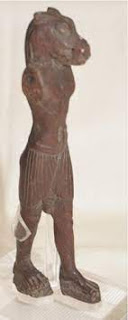Dr. Alice C. Linsley
The historical Adam was the father of three sons: Cain, Abel, and Seth. The Bible does not name any descendants of Abel. Some of Cain's descendants are listed in Genesis 4 and some of Seth's descendants are listed in Genesis 5. The lines of Cain and Seth intermarried (endogamy). That is shown in the diagram.
Lamech the Elder (Gen. 4) had a daughter named Naamah. She married her cousin Methuselah and named their firstborn son Lamech, after her father. This is an example of the cousin bride's naming prerogative, a distinctive feature of the marriage and ascendancy pattern of the early Hebrew (5000-2000 BC).
The rulers listed in Genesis chapters 4, 5, 10, 11, 25 and 36 were members of the Hebrew ruler-priest caste. As is common with castes, they practiced endogamy. By marrying only members of their caste, certain genetic traits were passed to their descendants. Apparently, a red to red-brown skin tone was one of those traits.
The Sethite Hebrew were a well-established moiety of the Hebrew caste by 2400 BC because their sacred sites are mentioned in texts that date to 2400 BC. This means that the historical Adam probably lived between c.5000-4800 BC.
The Sethites served at the sacred high places (mounds) along the Nile and are mentioned many times in the Ancient Pyramid Texts (2400-2200 BC). One place where figurines of Seth were found is Nekhen on the Nile. The city was dedicated to the son of the High God, HR (Horus in Greek). HR in ancient Egyptian means "Most High One."
Seth is often portrayed in ancient images as a red hippo. Seth’s homeland is the land of Seti, at the northern edge of the Upper Nile. This region is sometimes referred to as the land of red earth.
According to Genesis 5:3, Seth was a son in the image of his
father Adam. This likely means that he had a red skin tone. The word “Adam”
refers to blood (dam in Hebrew, dammu in Ancient Akkadian) and
the color red. Adam is derived from the root אדם (A.D.M), meaning "to be red or
ruddy" (Strong’s #119). Jeff A. Benner explains, Dam is the
"red" blood, adamah is the "red" ground, edom
is the color "red" and adam is the "red" man.
The connection between the terms adam (red man) and adamah (red soil) is evident in Genesis 2:7 which states that "the adam" was formed out of the "adamah." The region of the Nile under consideration has a cambic B horizon. Chromic cambisols have a strong red brown color.
Related reading: Horite and Sethite Mounds; Adam and Estrangement from God; Funerary Rites and the Hope of Resurrection; African = Black is a Modern Equation



No comments:
Post a Comment
Your comments are welcome. Please stay on topic and provide examples to support your point.